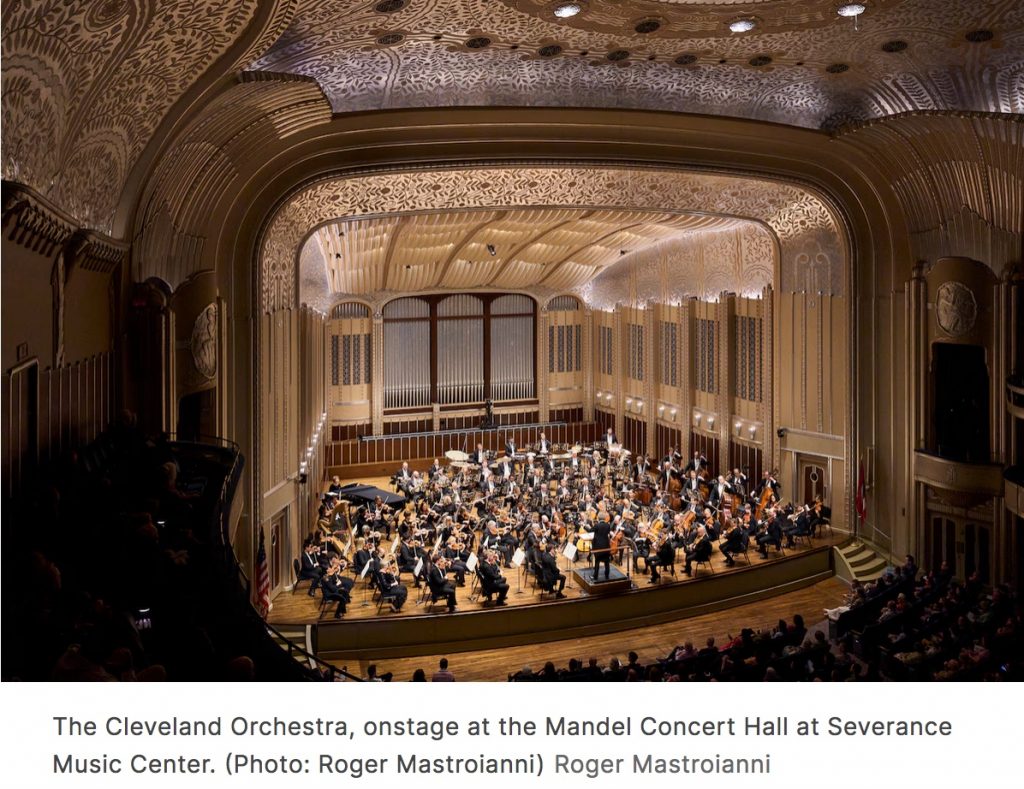
Originally published on Cleveland.com
CLEVELAND, Ohio — Two forest-themed works and a picture of a noir-suffused city that never sleeps formed a riveting Cleveland Orchestra program on Thursday evening April 4 in Mandel Concert Hall at Severance Music Center under the direction of guest conductor John Adams.
A good way to convince someone to care more about trees is to take them on a hike. American naturalist John Muir, who hiked with common folk and presidents alike, encouraged everyone to “climb the mountains and get their good tidings.”
Another way is to bring the trees to the people. Gabriella Smith did just that with Breathing Forests, her mesmerizing 30-minute organ concerto, composed in 2021 for James McVinnie, who was soloist on Thursday.
Besides writing music, the composer’s greatest passion, as she highlighted in her introductory remarks, is ecosystem restoration — with a recent project restoring a naval airfield back to its forested state a case in point. “Destruction brought on by climate change,” she said, “is not inevitable. Change is possible.”
The concerto unfolds in three contiguous movements — “Grow,” “Breathe,” and “Burn,” which portray the life cycle of trees and their ongoing carbon dioxide-oxygen exchange with human beings. Smith also reflects on the destructive and regenerative nature of fire, posed by climate change and poor forest management.
Rather than oppose the soloist and the orchestra, as is often done in a concerto, Smith incorporates and integrates the two. And because the organ is such a sonic chameleon, you can’t always tell where a particular sonority is coming from. The variety and grandeur of the instrument are Smith’s proxy for the network of trees.
In “Grow,” instruments tweet, chatter, whine, rustle, and groan. In “Breathe,” you could swear you heard the forest inhale and exhale, and branches sprout. “Burn” opens with a myriad of sylvan sounds in the orchestra: tremolo and other effects in the strings and unorthodox wind timbres. A magical combination of harmonics, plucked strings, and scratch-bow techniques eerily simulated the first cracklings of a fire.
“Burn” grows into a mighty conflagration, nourished by a group cadenza for the full orchestra and organ. Percussion instruments were nowhere in evidence, narrowing the composer’s sound palette — or maybe freeing up her imagination.
Otherwise Smith left it to McVinnie to create his evocative stop combinations.
Debussy’s Prelude to the Afternoon of a Faun imagined an entirely different forest. Adams permitted the piece — an ode to daydreaming — to unfold leisurely, with such subtle shifts in timbre and rhythm that they seemed improvised. It was a disorienting world — arcadian and delicate — owing not least to wonderful solos from principal players: flutist Joshua Smith, hornist Nathan Silbershlag, and clarinetist Afendi Yusuf.
John Adams’ City Noir (2009) was commissioned by the Los Angeles Philharmonic and premiered in that city by Gustavo Dudamel in his debut concert as the orchestra’s music director. The three-movement quasi-concerto featuring saxophone soloist Timothy McAllister conjures the dark and mysterious Los Angeles of the 1940s and ‘50s.
From the very beginning we know we’re never going to get any rest. There is more activity in the opening movement, “The City and its Double,” than you can shake a pulp novel at: restless strings, volleys of brass notes — probably bullets — syncopated winds nodding in and out in an accumulating frenzy. It’s a rat race in the city.
McAllister’s role was to contribute intermittently to the texture, like a guy practicing in a neighboring apartment between card games. At least they gave him a chair to sit in when he wasn’t playing — the city will wear you down.
The second movement, “The Song Is for You,” is softer though not always sweeter than the first. There is jazz here, along the lines of Duke Ellington’s and Billy Strayhorn’s score for Otto Preminger’s film “Anatomy of a Murder,” though Ellington’s supreme trombonist Juan Tizol could not have played a tastier solo than Brian Wendel did on Thursday. McAllister also soared beautifully here, against strings, vibraphone, and solo horn.
The finale, “Boulevard Night,” begins against a comely backdrop of strings and winds, before a mysterioso trumpet solo — beautifully played by Michael Sachs — rouses the neighbors. About two-thirds of the way through, Adams introduces a locomotive pattern in the strings overlaid by Latin-infused, Bernstein-like rhythms for a raucous climax — and probably a call to the cops. This city never sleeps.
Published on ClevelandClassical.com April 8, 2024.
Click here for a printable copy of this article


